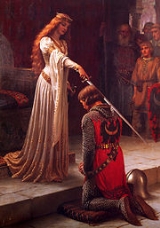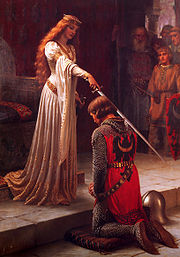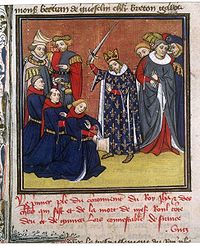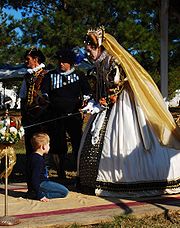
Accolade
Encyclopedia

Middle Ages
The Middle Ages is a periodization of European history from the 5th century to the 15th century. The Middle Ages follows the fall of the Western Roman Empire in 476 and precedes the Early Modern Era. It is the middle period of a three-period division of Western history: Classic, Medieval and Modern...
, the accolade (also known as dubbing or adoubement) was the central act in the rite-of-passage
Rite of passage
A rite of passage is a ritual event that marks a person's progress from one status to another. It is a universal phenomenon which can show anthropologists what social hierarchies, values and beliefs are important in specific cultures....
ceremonies
Ceremony
A ceremony is an event of ritual significance, performed on a special occasion. The word may be of Etruscan origin.-Ceremonial occasions:A ceremony may mark a rite of passage in a human life, marking the significance of, for example:* birth...
conferring knight
Knight
A knight was a member of a class of lower nobility in the High Middle Ages.By the Late Middle Ages, the rank had become associated with the ideals of chivalry, a code of conduct for the perfect courtly Christian warrior....
hood.
Ceremony
The accolade is a ceremony to confer knighthood that may take many forms including, for example, the tapping of the flat side of a swordSword
A sword is a bladed weapon used primarily for cutting or thrusting. The precise definition of the term varies with the historical epoch or the geographical region under consideration...
on the shoulder
Shoulder
The human shoulder is made up of three bones: the clavicle , the scapula , and the humerus as well as associated muscles, ligaments and tendons. The articulations between the bones of the shoulder make up the shoulder joints. The major joint of the shoulder is the glenohumeral joint, which...
s of a candidate or an embrace about the neck.
In the first example, the "knight-elect" kneels in front of the monarch
Monarch
A monarch is the person who heads a monarchy. This is a form of government in which a state or polity is ruled or controlled by an individual who typically inherits the throne by birth and occasionally rules for life or until abdication...
on a knighting-stool when the ceremony is performed. First, the monarch lays the flat side of the sword's blade
Blade
A blade is that portion of a tool, weapon, or machine with a cutting edge and/or a pointed tip that is designed to cut and/or puncture, stab, slash, chop, slice, thrust, or scrape animate or inanimate surfaces or materials...
onto the accolade's right shoulder. They then raise the sword gently just up over the apprentice's head and places it then on his left shoulder. The new knight then stands up after being promoted, and the King or Queen presents him with the insignia
Insignia
Insignia or insigne pl -nia or -nias : a symbol or token of personal power, status or office, or of an official body of government or jurisdiction...
of his new order
Chivalric order
Chivalric orders are societies and fellowships of knights that have been created by European monarchs in imitation of the military orders of the Crusades...
.

The blow, or colée, when first utilized was given with a naked fist. It was a forceful box on the ear or neck that one would remember. This was later substituted for by a gentle stroke with the flat part of the sword against the side of the neck. This then developed into the custom of tapping on either the right or left shoulder or both, which is still the tradition in Great Britain today.
An early Germanic coming-of-age ceremony, of presenting a youth with a weapon that was buckled on him, was elaborated in the 10th and 11th centuries as a sign that the minor
Minor (law)
In law, a minor is a person under a certain age — the age of majority — which legally demarcates childhood from adulthood; the age depends upon jurisdiction and application, but is typically 18...
had come of age
Coming of age
Coming of age is a young person's transition from childhood to adulthood. The age at which this transition takes place varies in society, as does the nature of the transition. It can be a simple legal convention or can be part of a ritual, as practiced by many societies...
. Initially this was a simple rite often performed on the battlefield, where writers of Romance enjoyed placing it. A panel in the Bayeux Tapestry
Bayeux Tapestry
The Bayeux Tapestry is an embroidered cloth—not an actual tapestry—nearly long, which depicts the events leading up to the Norman conquest of England concerning William, Duke of Normandy and Harold, Earl of Wessex, later King of England, and culminating in the Battle of Hastings...
shows the knighting of Harold
Harold Godwinson
Harold Godwinson was the last Anglo-Saxon King of England.It could be argued that Edgar the Atheling, who was proclaimed as king by the witan but never crowned, was really the last Anglo-Saxon king...
by William of Normandy
William I of England
William I , also known as William the Conqueror , was the first Norman King of England from Christmas 1066 until his death. He was also Duke of Normandy from 3 July 1035 until his death, under the name William II...
, but the specific gesture is not clearly represented. Another military knight (commander of an army), sufficiently impressed by a warrior's loyalty
Loyalty
Loyalty is faithfulness or a devotion to a person, country, group, or cause There are many aspects to...
, would strike a fighting soldier on the head or his back and shoulder with his hand and announce that he was now an official knight. Some words that might be spoken at that moment were Advances Chevalier au nom de Dieu.
The increasingly impressive ceremonies surrounding adoubement figured largely in the Romance literature
Romance (genre)
As a literary genre of high culture, romance or chivalric romance is a style of heroic prose and verse narrative that was popular in the aristocratic circles of High Medieval and Early Modern Europe. They were fantastic stories about marvel-filled adventures, often of a knight errant portrayed as...
, both in French
French language
French is a Romance language spoken as a first language in France, the Romandy region in Switzerland, Wallonia and Brussels in Belgium, Monaco, the regions of Quebec and Acadia in Canada, and by various communities elsewhere. Second-language speakers of French are distributed throughout many parts...
and in Middle English
Middle English
Middle English is the stage in the history of the English language during the High and Late Middle Ages, or roughly during the four centuries between the late 11th and the late 15th century....
, particularly those set in the Trojan War
Trojan War
In Greek mythology, the Trojan War was waged against the city of Troy by the Achaeans after Paris of Troy took Helen from her husband Menelaus, the king of Sparta. The war is among the most important events in Greek mythology and was narrated in many works of Greek literature, including the Iliad...
or around the legendary personage of Alexander the Great.
In the Netherlands the knights in the exclusive Military Order of William (the Dutch "Victoria Cross") are striken on both shoulders with the palm of the hand, first by the Dutch monarch (if present) then by the other knights. The new knight does not kneel.

Promotion steps
The process of becoming a knight generally included these stages:- PagePage (servant)A page or page boy is a traditionally young male servant, a messenger at the service of a nobleman or royal.-The medieval page:In medieval times, a page was an attendant to a knight; an apprentice squire...
— A child started training at about the age of seven or eight, learning obedience, manners, and other skills.
- SquireSquireThe English word squire is a shortened version of the word Esquire, from the Old French , itself derived from the Late Latin , in medieval or Old English a scutifer. The Classical Latin equivalent was , "arms bearer"...
— At 12 to 14 the young man would observe and help other knights (comparable to an apprenticeshipApprenticeshipApprenticeship is a system of training a new generation of practitioners of a skill. Apprentices or protégés build their careers from apprenticeships...
). He would learn fighting techniques by handing them their arrows and watching how they fought. He would also go hunting with other knights to learn how to use weapons. He would go into recruit trainingRecruit trainingRecruit training, more commonly known as Basic Training and colloquially called Boot Camp, is the initial indoctrination and instruction given to new military personnel, enlisted and officer...
to learn how to become a military fighter. At age 21, if worthy, he was bestowed the accolade of knighthood.
- Knight — A special kind of trained soldierSoldierA soldier is a member of the land component of national armed forces; whereas a soldier hired for service in a foreign army would be termed a mercenary...
, often cavalryCavalryCavalry or horsemen were soldiers or warriors who fought mounted on horseback. Cavalry were historically the third oldest and the most mobile of the combat arms...
, serving a lordLordLord is a title with various meanings. It can denote a prince or a feudal superior . The title today is mostly used in connection with the peerage of the United Kingdom or its predecessor countries, although some users of the title do not themselves hold peerages, and use it 'by courtesy'...
(noblemanNobilityNobility is a social class which possesses more acknowledged privileges or eminence than members of most other classes in a society, membership therein typically being hereditary. The privileges associated with nobility may constitute substantial advantages over or relative to non-nobles, or may be...
or royaltyRoyal familyA royal family is the extended family of a king or queen regnant. The term imperial family appropriately describes the extended family of an emperor or empress, while the terms "ducal family", "grand ducal family" or "princely family" are more appropriate to describe the relatives of a reigning...
). Knights had particular status in feudal society.
Other meanings
Accolade was first used in 1611 and is French, from the Occitan acolada. This, in turn, came from the LatinLatin
Latin is an Italic language originally spoken in Latium and Ancient Rome. It, along with most European languages, is a descendant of the ancient Proto-Indo-European language. Although it is considered a dead language, a number of scholars and members of the Christian clergy speak it fluently, and...
ad ("to") + collum ("neck") and in Occitan originally meant "embrace".
Accolade is akin to "dubbing" or "to dub" since the tap on the shoulder with the sword is accepted to be the point at which the title is awarded.
Clergy
Clergy
Clergy is the generic term used to describe the formal religious leadership within a given religion. A clergyman, churchman or cleric is a member of the clergy, especially one who is a priest, preacher, pastor, or other religious professional....
receiving a knighthood are not dubbed. The use of a sword in this kind of a ceremony is believed to be inappropriate.
From about 1852, the meaning of "accolade" was extended to mean "praise" or "award" or "honour."

